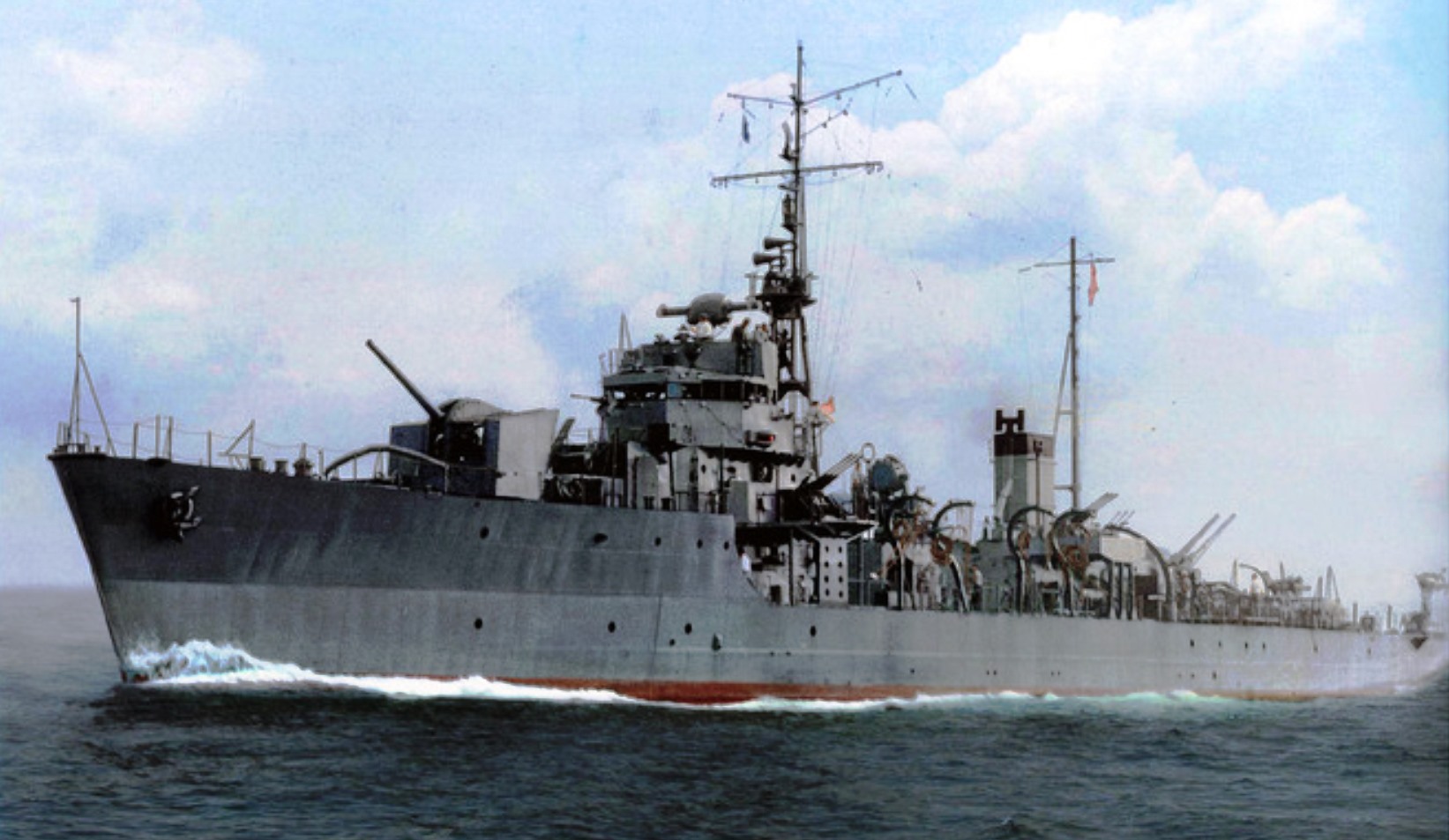© 2009-2016 Bob Hackett and Peter Cundall
Revision 1
20 October 1944:
Uraga, Kanagawa Prefecture. Laid down at Uraga Dock Company’s shipyard, as Yard No. 573.
31 December 1944:
Launched and named KOZU .
10 January 1945:
LtCdr Kido Yoshihiko is posted Chief Equipping Officer.
7 February 1945:
Completed and registered in the Sasebo Naval District. Attached to the Kure Guard Unit´s
anti-submarine training force. LtCdr Kido is the Commanding Officer. Complement is 250. Departs Uraga for Yokosuka.
Later this day arrives at Yokosuka where KOZU is provisioned and ammunitioned.
6 March 1945:
Departs Yokosuka.
8 March 1945:
At 1100, KOZU passes off Esu-zaki, Wakayama Prefecture, course west, 13 knots.
11 March 1945:
Arrives at Kure.
23 March–5 May 1945:
Initially based at Saeki and later at Nanao, KOZU conducts intensive anti-air and anti-sub training.
5 May 1945:
Attached to the 1st Coast Defence Force in the 1st Escort Fleet.
6 May 1945:
CO Maizuru Naval District issues order to prevent enemy submarines from intruding into the Sea of Japan. KOZU is
instructed to conduct anti-sub patrols in Korea Strait.
26 May 1945:
Departs Maizuru.
27 May 1945:
Arrives at Chinkai (Chinhae), south coast of Korea.
27 May–15 June 1945:
While based at Chinkai, KOZU patrols between Reisui (Yosu) and Azuchi Bay, Azuchi-Oshima Island, Nagasaki Prefecture
in co-operation with other kaibokan. One day KOZU´s radar catches an enemy submarine. KOZU makes a depth charge attack,
but without result.
19 June 1945:
KOZU is ordered to perform escort duty for the Fusan (Pusan) – Shimonoseki ferry service. However, due to the severe
mine-laying campaign by the US Air Force against important Japanese harbors it is impossible to enter Shimonoseki
Harbor. Therefore the Fusan ferry service has to make way for other small ports on the Sea of Japan coast.
20–21 June 1945:
KOZU escorts a ferry between Fusan and Senzaki, Yamaguchi Prefecture.
23–27 June 1945:
KOZU escorts a ferry between Fusan, Hagi, Yamaguchi Prefecture and Fukawa Bay, just to the west of Senzaki.
28 June – 4 July 1945:
KOZU escorts a ferry between Fusan and Susa, Yamaguchi Prefecture.
7 – 20 July 1945:
KOZU escorts evacuation convoys between Chinkai, Yushin (Yujin), NE Korea and Nanao.
8 -15 August 1945:
Conducts anti-sub patrols between Nanao and Maizuru.
15 August 1945:
KOZU is patrolling off Noto Peninsula when, at ca. 0900, a radio message is received from the Maizuru Naval District
saying that Japan has surrendered and all combat activities are to be ceased. KOZU terminates her anti-sub patrol and
proceeds quickly to Maizuru.
16 August 1945:
KOZU arrives at Maizuru. LtCdr Kido attends the Maizuru Naval District Office where he is informed about Japan´s
unconditional surrender.
30 November 1945:
Removed from the Navy List.
1 December 1945:
Assigned to the Allied Occupation Forces as a minesweeper. [1]
28 August 1947:
Nakhodka Bay, Siberia, Maritime Province. KOZU is ceded to the Soviet Navy as a war reparation. She serves in the
Soviet Pacific Fleet as patrol ship EK-47 (1947), oceanographic research ship NORD (1948), later as GLUBOMER (1953),
repair ship PM-62 (1955).
25 January 1969:
Decommissioned and scrapped.
Authors' Note:
[1] In 1945, the U. S. Army Air Force launched a five-phased
campaign known as “Operation Starvation” to mine Japan’s home waters. The USAAF
used 80 to 100 B-29 “Super Fortress” heavy bombers of the 21st Bomber Command
based at Tinian in the Marianas. The B-29s could carry seven 2,000 lb. or twelve
1,000 lb. mines.
Beginning on 27 March 1945 and continuing until 5 August 1945, the B-29s
flew 1,529 nighttime radar sorties and laid 4,900 magnetic, 3,500 acoustic,
2,900 pressure and 700 low-frequency mines for a total of more than 12,000 mines
laid in Japanese waters. These mines sank 294 ships, damaged 137 beyond repair
and damaged another 239 that could be repaired. The total was 1, 250,000 tons
sunk or damaged or about 75 percent of Japanese shipping available in March
1945. Only 15 B-29s were lost during the mining campaign.
Postwar, removal of these mines posed a major challenge for the Allied
Occupation Forces. They pressed 269 Japanese ships of various types into mine
sweeping service to augment their own efforts.
Thanks go to Matthew Jones for help in identifying COs. Many thanks go to Erich Muehthaler of Germany for the
almost complete rewrite of the TROM in Rev 1.
-Bob Hackett and Peter Cundall
Back to
Escort Page



